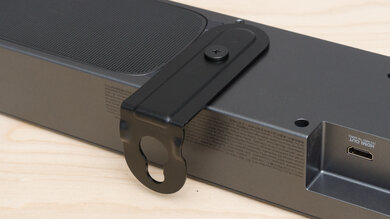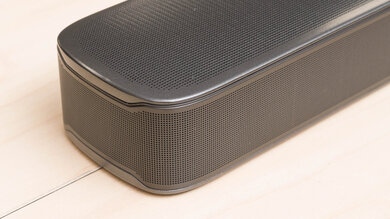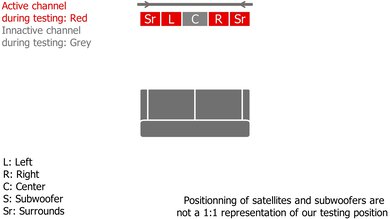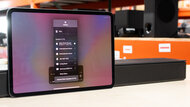The JBL Bar 5.0 MultiBeam is a compact 5.0 setup from 2021. It comes with JBL MultiBeam Technology, advertised to help create a wider soundstage by bouncing sound off your walls. With its room correction feature, it has a boxy sound profile that adds punch and boom to your mixes but struggles to reproduce a deep low-bass. Also, it supports Virtual Dolby Atmos, meaning that it can only play Atmos content when downmixing it to surround content, which isn't as immersive.
Our Verdict
The JBL Bar 5.0 is decent for mixed usage. With its room correction feature turned on, this soundbar offers a boxy sound profile out-of-the-box, which adds a little extra punch and boom to your audio. However, it struggles to reproduce a thumpy low-bass, so you don't feel the rumble in bass-heavy music and action-packed movies. It supports surround and Dolby Atmos content, but unfortunately, it doesn't offer a very immersive performance.
- Bass adjustment feature.
- Gets pretty loud.
- Lacks low-bass.
- No dialogue enhancement feature.
The JBL Bar 5.0 is decent for dialogue-centric content like TV shows. Thanks to its dedicated center channel and balanced mid-range, voices are reproduced clearly and accurately. It also offers lots of wireless playback options so you can stream podcasts and audiobooks from your phone to the bar. It comes with an auto-volume mode to help balance the volume level between programs, but unfortunately, it lacks a dialogue enhancement feature.
- Auto-volume mode.
- No dialogue enhancement feature.
The JBL Bar 5.0 is decent for music. It comes with a room correction feature called Automatic MultiBeam Calibration that adjusts audio reproduction based on the room you're listening in. With this feature on, it offers a boxy sound profile that adds extra punch and boom to your mixes. However, it struggles to reproduce a deep, thumpy low-bass. There's a bass adjustment feature to help you customize its sound, but it lacks more robust sound customization options.
- Bass adjustment feature.
- Gets pretty loud.
- Lacks low-bass.
- No graphic EQ.
The JBL Bar 5.0 is decent for movies. Out-of-the-box, it has a boxy sound profile that adds a little extra punch and boom to your favorite movies. However, it struggles to reproduce low-bass, so you don't feel the deep rumble in action-packed scenes. It supports surround content, but it doesn't offer very impressive performance. Also, it has to downmix Dolby Atmos content into surround, which isn't as immersive.
- Bass adjustment feature.
- Lacks low-bass.
Changelog
- Updated Dec 12, 2023: Added market comparison with the Sennheiser AMBEO Soundbar Mini in the Sound Enhancement Features box.
- Updated Mar 27, 2023: Added cable lengths to In The Box.
- Updated Mar 22, 2023: Converted to Test Bench 1.1. With this update, we've added a Mounting test and added information aboutSubwoofer Output, Spotify Connect, and Microphone Mute.
- Updated May 28, 2021: Review published.
Check Price
Differences Between Sizes And Variants
The JBL Bar 5.0 MultiBeam comes in 'Black', and you can see the label for the model we tested here.
If you come across another version of this soundbar, let us know in the discussions, and we'll update our review.
Popular Soundbar Comparisons
The JBL Bar 5.0 MultiBeam is a 5.0 soundbar that supports Virtual Dolby Atmos, so it has to downmix Atmos content into surrounds to play it. It has a boxy sound profile out-of-the-box, and it comes with an Automatic MultiBeam Calibration room correction feature. It also offers lots of wireless playback support.
See our recommendations for the best soundbars, the best small soundbars, and the best soundbars under $500.
The Sonos Beam (Gen 2) is better than the JBL Bar 5.0 MultiBeam. The Sonos is better built and has better soundstage, surround, and Atmos performances. That said, the JBL does get a bit louder with less compression at max volume. Unlike the Sonos, it's also Bluetooth compatible and it a Full HDMI In port for high-quality passthrough.
The JBL Bar 500 is better than the JBL Bar 5.0 MultiBeam. The MultiBeam is a standalone soundbar that doesn't come with a dedicated subwoofer, and it can't reproduce as much bass as the 500. Plus, it doesn't have as many sound enhancement features, and it has some implementation issues with certain audio formats, like Dolby Digital, which takes away from the life-like experience intended by those who mix content in this format.
The JBL Bar 5.0 MultiBeam is a better soundbar than the Bose Smart Soundbar 300. The JBL is a 5.0 setup with a better surrounds performance and Atmos support. It comes with a room correction feature, EQ presets, and a Full HDMI In port, too. That said, the 3.0 Bose has a better soundstage performance.
The Sonos Arc is a better soundbar than the JBL Bar 5.0 MultiBeam. The Sonos has a better soundstage performance, and thanks to its two up-firing speakers, it also has a better Atmos performance. You can even upgrade it to the Sonos Arc with Sub + One SL Speakers. However, the JBL is more compact and has some EQ presets and a Full HDMI In port.
Test Results

The JBL Bar 5.0 MultiBeam has a decent stereo frequency response. With its Automatic MultiBeam Calibration room correction feature turned on, it has a slightly boxy sound profile that adds extra punch and boom to your audio. However, it struggles to reproduce a deep low-bass, disappointing if you like thumpy music like EDM or hip-hop and action-packed movies. It comes with a bass adjustment feature and some EQ presets to help you customize its sound.
Note: This soundbar's default bass setting is '3'. During our testing for stereo files, we turned SMART Mode Off. Stereo content played from the two front channels as well as both side surrounds.
With calibration, the JBL Bar 5.0 MultiBeam has a decent stereo frequency response. With its bass set to '1', it offers a more neutral, balanced sound profile suitable for listening to lots of different types of audio content. However, it still struggles to reproduce a thumpy low-bass, so you don't feel the deep rumble in action-packed scenes.
The JBL Bar 5.0 MultiBeam has a decent stereo soundstage performance. The soundstage is perceived to be a bit wider than the bar itself, but the bar isn't wide to begin with. Its focus is okay, so objects in the soundstage like voices and footsteps seem to come from a more general area rather than a pinpoint location.
The JBL Bar 5.0 MultiBeam has good dynamics. It can get pretty loud, though not quite as loud as some of the other bars we've tested, like the Sonos Arc. There isn't too much compression present when you play it at max volume, which is handy if you like to turn up the volume for parties.
The JBL Bar 5.0 MultiBeam has an impressive THD performance. At normal listening volumes, distortion falls within good limits, resulting in clean and pure audio reproduction. There's a slight jump in distortion when you push the bar to max volume, but this may not be too noticeable with real-life content.
The JBL Bar 5.0 MultiBeam has a great center channel performance. This 5.0 setup comes with a discrete center channel, which helps reproduce dialogue more clearly and accurately. It struggles to reproduce low-bass, but this shouldn't be too noticeable since there generally isn't much bass in audio content played on the center channel.
The JBL Bar 5.0 MultiBeam has a mediocre surrounds performance. It uses its front and side-firing speakers to create a phantom localization. However, this doesn't sound as clear and real as discrete surround setups, so objects in the soundstage like voices and footsteps aren't as clearly or accurately represented. Audio seems like it's coming from in front of you rather than from speakers placed all around you.
Note: During our testing for surround files, we turned SMART Mode on and Dolby Atmos off. Surround content played from the side-firing drivers as well as the two front-firing drivers.
The JBL Bar 5.0 MultiBeam has a disappointing Atmos performance. This soundbar doesn't come with dedicated Atmos drivers. Instead, it plays Atmos content from its side and front-firing channels using Dolby Atmos Virtual technology. Since it has to downmix Atmos content into surround to play it, it doesn't sound as clear or real as a discrete setup.
The JBL Bar 5.0 MultiBeam has a poor selection of sound enhancement features, especially compared to other small bars like the Sennheiser AMBEO Soundbar Mini. It comes with an Automatic MultiBeam Calibration room correction feature, which automatically optimizes audio reproduction based on the unique acoustic characteristics of your room. You can also choose between the two EQ presets, SMART Mode On and Off. The manufacturer recommends turning SMART Mode Off when listening to TV programs to reduce sound effects. Turning SMART Mode On enables the JBL Surround Sound feature, which is advertised to help create a more three-dimensional sound. Though it isn't in the manual, you can press the MUTE button for two seconds, followed by the - button to activate auto-volume mode. There's also a Sync feature to help reduce latency with videos, though we don't test for this.
The JBL Bar 5.0 MultiBeam comes with some physical inputs. There's a Full HDMI In port, so you can use the bar as a hub between different devices. Also, the US version of this soundbar comes with a USB port for audio playback. International versions of the bar come with a USB port, but it's only for servicing the bar.
The JBL Bar 5.0 MultiBeam has excellent audio format support via ARC. It supports Dolby Digital, which is the most common surround sound format. It also supports some object-based formats, like Dolby Atmos.
The JBL Bar 5.0 MultiBeam has amazing audio format support via Full HDMI In. It supports Dolby Digital, which is commonly found on Blu-ray discs and streaming platforms.
The JBL Bar 5.0 MultiBeam can play Dolby Digital via Optical. You can find this format on most streaming services and some Blu-ray discs. Unfortunately, it doesn't support DTS content, which is even more common on Blu-ray.
The JBL Bar 5.0 MultiBeam Soundbar has an incredible latency performance. It has low latency over its ARC, Optical, and Full HDMI In ports, so video and audio are in sync. As a result, it's suitable for watching videos and movies over these connections. However, some apps and TVs compensate for latency differently, so your real-world experience may vary.
The JBL Bar 5.0 MultiBeam has fantastic wireless playback connectivity. You can stream audio from your mobile devices to the bar wirelessly over all the formats we test for.
The JBL Bar 5.0 can passthrough the highest bandwidth signals. When you connect the bar to your TV and your PC, text on the screen appears crisp and clear.
The JBL Bar 5.0 MultiBeam doesn't have built-in voice assistant support. According to the manufacturer, it supports voice assistants when you connect a third-party device like a Google Home to the bar. Since this requires a separate purchase, we don't test for it.


































